语言学简答题
语言学考试题及答案英语
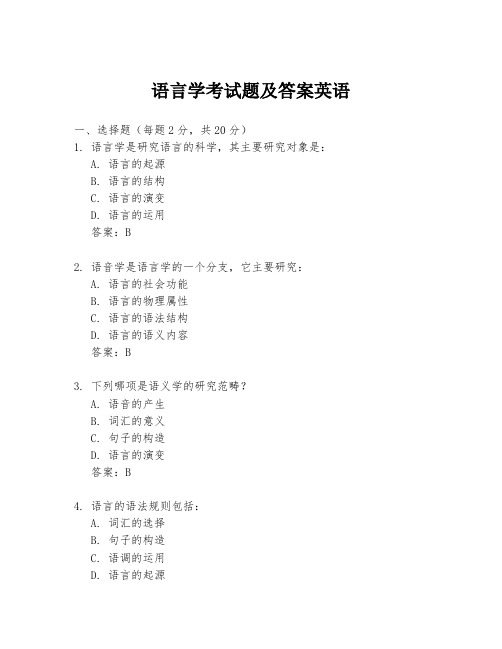
语言学考试题及答案英语一、选择题(每题2分,共20分)1. 语言学是研究语言的科学,其主要研究对象是:A. 语言的起源B. 语言的结构C. 语言的演变D. 语言的运用答案:B2. 语音学是语言学的一个分支,它主要研究:A. 语言的社会功能B. 语言的物理属性C. 语言的语法结构D. 语言的语义内容答案:B3. 下列哪项是语义学的研究范畴?A. 语音的产生B. 词汇的意义C. 句子的构造D. 语言的演变答案:B4. 语言的语法规则包括:A. 词汇的选择B. 句子的构造C. 语调的运用D. 语言的起源答案:B5. 社会语言学主要关注语言与:A. 个人心理B. 社会结构C. 语言的演变D. 文化传承答案:B6. 心理语言学研究的是:A. 语言与社会的关系B. 语言与心理的关系C. 语言与文化的关系D. 语言与物理的关系答案:B7. 语言的产生和发展与人类的哪项能力密切相关?A. 逻辑思维B. 语言模仿C. 抽象思维D. 社会交往答案:D8. 语言的方言是指:A. 同一语言的不同变体B. 不同语言之间的相似性C. 语言的起源D. 语言的演变答案:A9. 语言的标准化是指:A. 语言的简化B. 语言的统一C. 语言的规范化D. 语言的创新答案:C10. 语言的借词是指:A. 从其他语言借用的词汇B. 同一语言内部的词汇C. 语言的起源D. 语言的演变答案:A二、填空题(每题2分,共20分)1. 语言学的分支包括语音学、语法学、语义学、__________和心理语言学。
答案:社会语言学2. 语言的最小意义单位是__________。
答案:语素3. 语言的音位是__________的最小单位。
答案:语音4. 语言的词汇包括基本词汇和__________。
答案:派生词汇5. 语言的句法结构包括词法和__________。
答案:句法6. 语言的语用学研究的是语言的__________。
答案:使用7. 语言的方言差异可能导致__________。
大学语言学试题
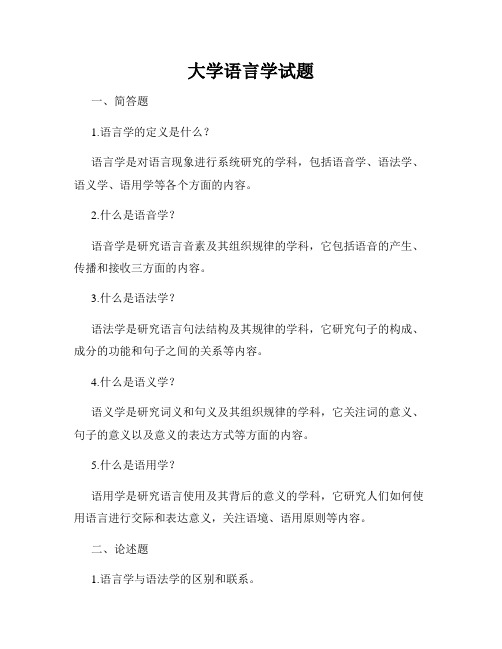
大学语言学试题一、简答题1.语言学的定义是什么?语言学是对语言现象进行系统研究的学科,包括语音学、语法学、语义学、语用学等各个方面的内容。
2.什么是语音学?语音学是研究语言音素及其组织规律的学科,它包括语音的产生、传播和接收三方面的内容。
3.什么是语法学?语法学是研究语言句法结构及其规律的学科,它研究句子的构成、成分的功能和句子之间的关系等内容。
4.什么是语义学?语义学是研究词义和句义及其组织规律的学科,它关注词的意义、句子的意义以及意义的表达方式等方面的内容。
5.什么是语用学?语用学是研究语言使用及其背后的意义的学科,它研究人们如何使用语言进行交际和表达意义,关注语境、语用原则等内容。
二、论述题1.语言学与语法学的区别和联系。
语言学是对语言现象进行全面研究的学科,涵盖了语音学、语法学、语义学和语用学等方面的内容。
而语法学是语言学的一个分支,主要研究语法现象及其规律。
语言学与语法学的联系在于语法学是语言学的重要组成部分,它提供了研究语言结构和规律的方法和理论基础。
同时,语法学的研究结果也为语言学的其他方面提供了重要的参考。
然而,语言学与语法学的区别在于语言学更加宏观和综合,它研究语言的各个方面,包括语音、词汇、句法、语义和语用等。
而语法学则是语言学中具体研究句法现象的一个分支,着重研究句子的构成、成分的功能和句子之间的关系。
2.语音学与音系学的关系。
语音学研究语音的产生、传播和接收,它是语言学的一个重要分支学科。
而音系学则是语音学中研究语言音素及其组织规律的一个分支领域。
语音学通过观察和记录语音现象,研究不同语音之间的差异和共性。
而音系学则在此基础上进一步研究语言中的音素及其分类、组织以及声音之间的相互关系。
简言之,语音学是对语音现象的整体研究,而音系学是语音学中对语音结构及其规律的具体研究。
三、分析题1.什么是语言的意义?语言的意义是指语言表达所传递的信息内容。
它涉及词汇意义、句子意义和话语意义等多个层次。
语言学考试题库及答案
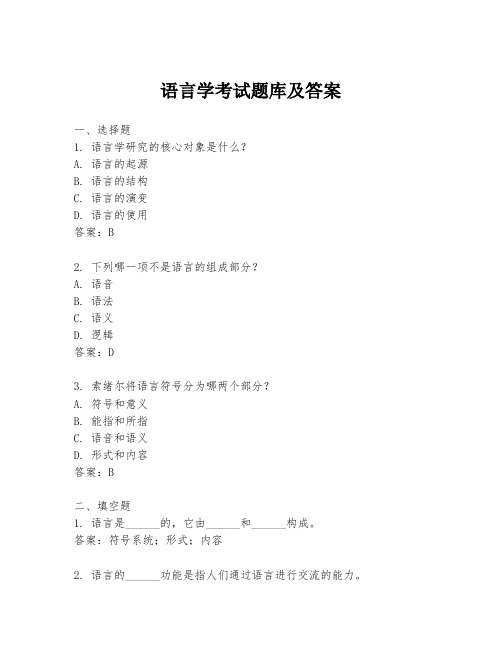
语言学考试题库及答案一、选择题1. 语言学研究的核心对象是什么?A. 语言的起源B. 语言的结构C. 语言的演变D. 语言的使用答案:B2. 下列哪一项不是语言的组成部分?A. 语音B. 语法C. 语义D. 逻辑答案:D3. 索绪尔将语言符号分为哪两个部分?A. 符号和意义B. 能指和所指C. 语音和语义D. 形式和内容答案:B二、填空题1. 语言是______的,它由______和______构成。
答案:符号系统;形式;内容2. 语言的______功能是指人们通过语言进行交流的能力。
答案:交流3. 语言的______功能是指语言能够表达思想和情感的能力。
答案:表达三、简答题1. 简述语言和言语的区别。
答案:语言是指一种抽象的符号系统,它包括语音、语法、语义等规则和结构;言语则是指个人使用语言进行交流的具体行为。
2. 描述索绪尔的“能指”和“所指”概念。
答案:索绪尔认为语言符号由“能指”和“所指”两部分组成。
“能指”指的是语言符号的声音形式,而“所指”指的是符号所代表的概念或意义。
四、论述题1. 论述语言的任意性原则及其对语言学习和教学的影响。
答案:语言的任意性原则指的是语言符号的声音形式和它所代表的概念之间没有必然的联系。
这一原则对语言学习和教学有着深远的影响,因为它意味着学习者需要记忆每个符号的声音和意义之间的联系,而不能依赖于逻辑或直观的关联。
这对语言教学提出了挑战,要求教师设计有效的教学方法来帮助学生记忆和理解这些任意的联系。
2. 分析语言的交际功能及其在现代社会中的重要性。
答案:语言的交际功能是指语言作为交流工具,使人们能够传递信息、表达情感和进行社会互动。
在现代社会,随着全球化和信息技术的发展,语言的交际功能变得尤为重要。
有效的沟通能够促进国际合作、文化交流和商业交易,同时也有助于解决社会冲突和增进理解。
因此,掌握一门或多门语言对于个人和社会的发展至关重要。
语言学概论简答题
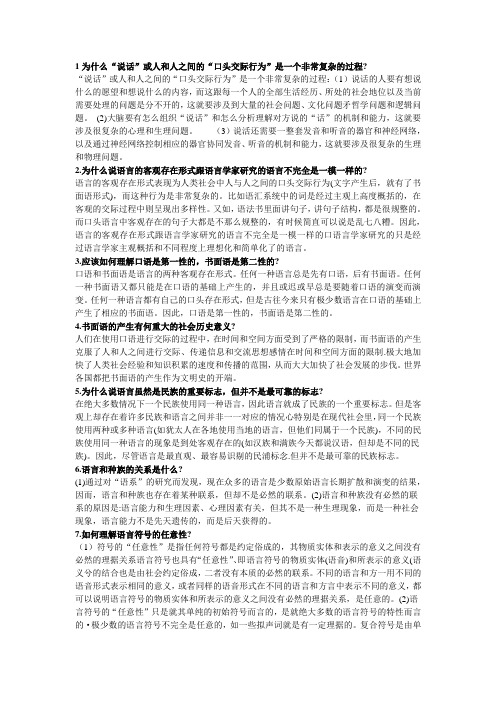
1为什么“说话”或人和人之间的“口头交际行为”是一个非常复杂的过程?“说话”或人和人之间的“口头交际行为”是一个非常复杂的过程:(1)说话的人要有想说什么的愿望和想说什么的内容,而这跟每一个人的全部生活经历、所处的社会地位以及当前需要处理的问题是分不开的,这就要涉及到大量的社会问题、文化问题矛哲学问题和逻辑问题。
(2)大脑要有怎么组织“说话”和怎么分析理解对方说的“话”的机制和能力,这就要涉及很复杂的心理和生理问题。
(3)说活还需要一整套发音和听音的器官和神经网络,以及通过神经网络控制相应的器官协同发音、听音的机制和能力,这就要涉及很复杂的生理和物理问题。
2.为什么说语言的客观存在形式跟语言学家研究的语言不完全是一模一样的?语言的客观存在形式表现为人类社会中人与人之间的口头交际行为(文字产生后,就有了书面语形式),而这种行为是非常复杂的。
比如语汇系统中的词是经过主观上高度概括的,在客观的交际过程中则呈现出多样性。
又如,语法书里面讲句子,讲句子结构,都是很规整的。
而口头语言中客观存在的句子大都是不那么规整的,有时候简直可以说是乱七八糟。
因此,语言的客观存在形式跟语言学家研究的语言不完全是一模一样的口语言学家研究的只是经过语言学家主观概括和不同程度上理想化和简单化了的语言。
3.应该如何理解口语是第一性的,书面语是第二性的?口语和书面语是语言的两种客观存在形式。
任何一种语言总是先有口语,后有书面语。
任何一种书面语又都只能是在口语的基础上产生的,并且或迟或早总是要随着口语的演变而演变。
任何一种语言都有自己的口头存在形式,但是古往今来只有极少数语言在口语的基础上产生了相应的书面语。
因此,口语是第一性的,书面语是第二性的。
4.书面语的产生有何重大的社会历史意义?人们在使用口语进行交际的过程中,在时间和空间方面受到了严格的限制,而书面语的产生克服了人和人之间进行交际、传递信息和交流思想感情在时间和空间方面的限制.极大地加快了人类社会经验和知识积累的速度和传播的范围,从而大大加快了社会发展的步伐。
语言学理论试题及答案
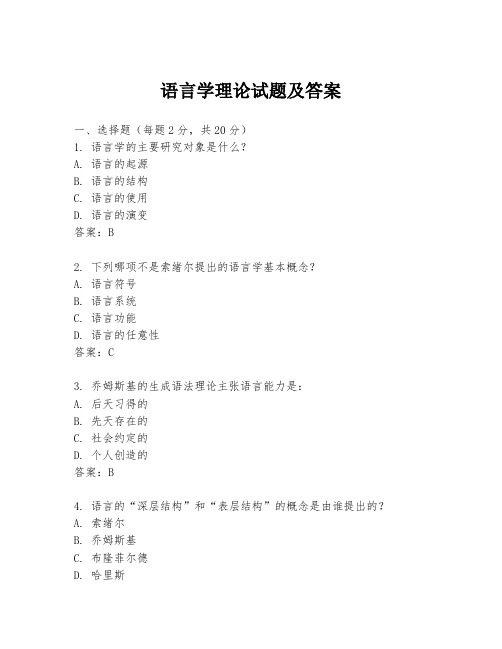
语言学理论试题及答案一、选择题(每题2分,共20分)1. 语言学的主要研究对象是什么?A. 语言的起源B. 语言的结构C. 语言的使用D. 语言的演变答案:B2. 下列哪项不是索绪尔提出的语言学基本概念?A. 语言符号B. 语言系统C. 语言功能D. 语言的任意性答案:C3. 乔姆斯基的生成语法理论主张语言能力是:A. 后天习得的B. 先天存在的C. 社会约定的D. 个人创造的答案:B4. 语言的“深层结构”和“表层结构”的概念是由谁提出的?A. 索绪尔B. 乔姆斯基C. 布隆菲尔德D. 哈里斯答案:B5. 语言的“同义异构”现象是指:A. 同一意义的不同表达方式B. 不同意义的相同表达方式C. 同一表达方式的不同意义D. 不同表达方式的相同意义答案:A6. 语言的“语境”指的是:A. 语言的内部结构B. 语言的外部环境C. 语言的使用者D. 语言的规则答案:B7. 语言的“语域”通常指的是:A. 语言的地域分布B. 语言的交际场合C. 语言的历史发展D. 语言的语法规则答案:B8. 语言的“语用学”研究的是:A. 语言的发音B. 语言的意义C. 语言的用法D. 语言的演变答案:C9. 语言的“语料库”是指:A. 语言的数据库B. 语言的规则集C. 语言的样本集D. 语言的词汇表答案:C10. 语言的“方言”是指:A. 同一语言的不同变体B. 不同语言的相似形式C. 同一语言的相同形式D. 不同语言的相同变体答案:A二、填空题(每题2分,共20分)1. 语言学的四大分支包括语音学、语法学、语义学和______。
答案:语用学2. 语言的“能指”指的是语言符号的______部分,而“所指”指的是语言符号的______部分。
答案:形式;意义3. 语言的“同音词”是指发音相同但______不同的词。
答案:意义4. 语言的“词缀”是指可以附加在词根上的______或______。
答案:前缀;后缀5. 语言的“句法”研究的是词、短语和句子的______。
语言学概论简答题
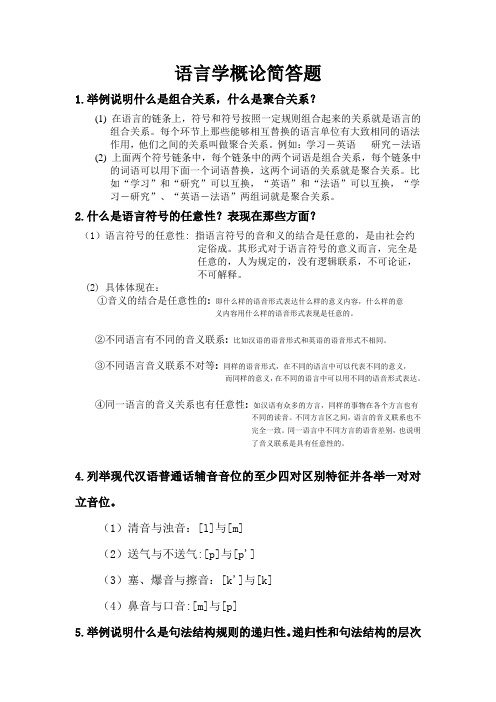
(2)送气与不送气:[p]与[p']
(3)塞、爆音与擦音:[k']与[k]
(4)鼻音与口音:[m]与[p]
5.举例说明什么是句法结构规则的递归性。递归性和句法结构的层次性有什么关系?
(1)例:“花红了”是主谓结构,通过偏正结构的递归性可以对其中的主语“花”进行扩展成为“玫瑰花红了”。又如“各级干部都必须参加集体生产劳动”这个句子的第一层是主谓结构,里面包含着四层偏正结构,一层述宾结构。像这样的结构的层层嵌套,同样的结构规则可以重复使用而不致造成结构上的混乱,借用数学的术语来说就是结构规则的递归性。
(4) 书面语是用文字的形式来传递人们的思想、观点等信息。它要求句子结构完整、严谨、工整,符合语法规则和行文要求,在恰当传递信息的基础上产生一定的修辞效果。书面语只能用别的手段来弥补不足:扩大用词的范围,使用比较复杂的句子结构,尽量排除废话,讲究篇章结构、连贯照应等。
(5)口语和书面语的这些差别是由使用条件决定的,它们是同一种语言的不同的风格变异。
汇系统中,发展变化较快的是一般词汇,基本词汇却是相当稳固的。
(2)不同时期语言发展变化不平衡。当社会变革较为剧烈、社会发展的步
伐较快、社会思维较为活跃、不同文化的接触较为频繁的时期,语言
发展变化的速度就会快一些;反之,语言发展变化的速度就会慢一些。
(3)语言变体发展变化不平衡。地域方言的形成,本身就是语言发展变化
而同样的意义,在不同的语言中可以用不同的语音形式表达。
④同一语言的音义关系也有任意性:如汉语有众多的方言,同样的事物在各个方言也有
不同的读音。不同方言区之间,语言的音义联系也不
完全一致。同一语言中不同方言的语音差别,也说明
简明语言学考试题及答案
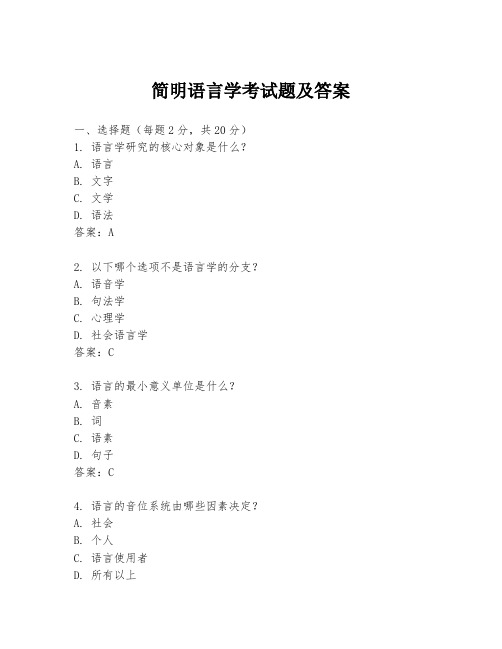
简明语言学考试题及答案一、选择题(每题2分,共20分)1. 语言学研究的核心对象是什么?A. 语言B. 文字C. 文学D. 语法答案:A2. 以下哪个选项不是语言学的分支?A. 语音学B. 句法学C. 心理学D. 社会语言学答案:C3. 语言的最小意义单位是什么?A. 音素B. 词C. 语素D. 句子答案:C4. 语言的音位系统由哪些因素决定?A. 社会B. 个人C. 语言使用者D. 所有以上答案:D5. 以下哪个术语是描述语言变化的?A. 语言演变B. 语言习得C. 语言接触D. 语言死亡答案:A6. 什么是方言?A. 一种语言的变体B. 一种语言的书面形式C. 一种语言的口语形式D. 一种语言的古语形式答案:A7. 以下哪个选项是语言的词汇特征?A. 语法性B. 音韵性C. 语义性D. 语音性答案:C8. 语言的语法结构包括哪些部分?A. 词法和句法B. 语音和语义C. 语素和词D. 词汇和语法答案:A9. 以下哪个选项是语言的交际功能?A. 信息传递B. 娱乐C. 教育D. 所有以上答案:D10. 什么是语言的规范性?A. 语言的规则性B. 语言的变异性C. 语言的随意性D. 语言的稳定性答案:A二、填空题(每题2分,共20分)1. 语言学研究的两个主要分支是______和______。
答案:理论语言学;应用语言学2. 语言学的四个基本子领域包括语音学、语法学、______和______。
答案:语义学;语用学3. 语言的最小音义结合体是______。
答案:词4. 语言的音位系统是由______决定的。
答案:语言的使用者5. 语言的演变过程包括语言的______、______和______。
答案:分化;传播;融合6. 方言是语言的______。
答案:变体7. 语言的词汇特征包括______、______和______。
答案:语法性;语义性;语音性8. 语言的语法结构由______和______组成。
语言学简答题

一结合语言学理论试将你所使用的方言或民族语言在语音,词汇,语法等方面与普通话作比较。
答:方言与普通话的区别1、概念不同:普通话是以北京语音为标准音,以北方话(官话)为基础方言,以典范的现代白话文著作为语法规范的现代标准汉语。
中国人口中所称“方言”是一个政治学概念,实为“地方语言”,又称“白话”,指的是区别于标准语的某一地区的语言,这种叫法不考虑语言间的亲属关系。
2、语法不同:普通话中,动词后面带双宾语时,指人的宾语在前,指物的宾语在后面。
如:“给我一本书。
”一些方言有时双宾语的语序与普通话相反。
如:“给本书我。
”云南方言属北方方言的西南方言区(不包括少数民族的民族语言)。
一直以来云南少数民族众多,语言混杂,给经济交往和文化交流颇多不便,汉唐以后汉文化逐渐传入,随着与中原地区的交往日渐深入(包括通商、通婚、和文化交流),汉语逐渐传入云南,特别是元明清时期中国现在的版图基本形成,为了加强对边疆地区的控制,大量的人口被迁往边疆地区,他们带来了先进的文化和生产技术促进了边疆地区的开发,同时在与当地少数民族通婚,交流的过程中互相影响形成了云南发言。
这也是少数民族被逐渐汉化的过程。
汉语的普遍使用是形成云南方言的先决条件。
云南方言以汉语为主体,经过了经千年的演变,汉语和云南方言在语音、词汇、语法方面有许多差异下面我们就从语音,词汇和语法方面来一一说明。
(对云南汉语方言的形成起了决定性的作用。
在经过千年的时间演化之后,云南方言与如今的普通话有什么区别呢?现从语音、词汇、语法方面作举例说明) 1. 语音(1)入声受自然环境和少数民族语言发音方式的影响,云南方言云南话用以结尾的字几乎全是入声,蜀黔虽然也大部分类似使用,但远非滇方言普遍。
通观三地方言,这样的例子不胜枚举。
如“变化”一次,在云南方言中,“化”字的发音在普通话“化”和“换”之间。
但云南方言的入声有些弱化,不如粤语明显。
而普通话中,入声早已消失。
(2)前后鼻音不分云南大多数地区前后鼻音不能分清。
语言学试题及答案
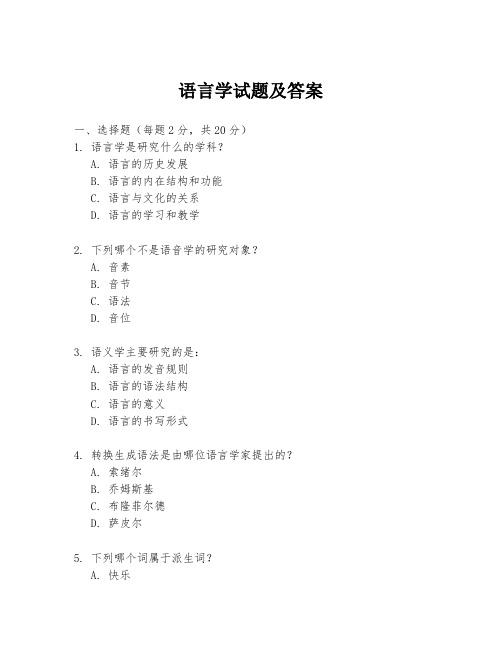
语言学试题及答案一、选择题(每题2分,共20分)1. 语言学是研究什么的学科?A. 语言的历史发展B. 语言的内在结构和功能C. 语言与文化的关系D. 语言的学习和教学2. 下列哪个不是语音学的研究对象?A. 音素B. 音节C. 语法D. 音位3. 语义学主要研究的是:A. 语言的发音规则B. 语言的语法结构C. 语言的意义D. 语言的书写形式4. 转换生成语法是由哪位语言学家提出的?A. 索绪尔B. 乔姆斯基C. 布隆菲尔德D. 萨皮尔5. 下列哪个词属于派生词?A. 快乐B. 快速C. 快乐地D. 快车6. 句法学研究的是:A. 句子的构成B. 词义的组合C. 语言的发音D. 语言的书写7. 社会语言学关注的是:A. 语言的变异与变化B. 语言与社会的关系C. 语言的起源和发展D. 语言的标准化8. 语言的功能主义理论是由下列哪位语言学家提出的?A. 索绪尔B. 乔姆斯基C. 韩礼德D. 布隆菲尔德9. 语言的同源词是指:A. 同一种语言中的不同词B. 不同语言中意义相同的词C. 来自同一词根的词D. 不同语言中发音相同的词10. 下列哪项不是语用学的研究内容?A. 语境B. 言语行为C. 语言的逻辑结构D. 语言的交际功能答案:1-5 B C C B D 6-10 A C B C C二、填空题(每题1分,共10分)1. 语言学的四个主要分支是语音学、语法学、语义学和________。
2. 索绪尔是________语言学的创始人。
3. 语言的任意性原则是指语言符号的_______和_______之间没有必然的联系。
4. 词类转换是指通过改变词的形式来改变其_______。
5. 语言的同化现象是指不同语言在交流中逐渐_______的现象。
6. 语言的方言是指同一语言内部由于_______、_______等因素而形成的不同变体。
7. 语言的借词是指一种语言从另一种语言中借用的_______或_______。
(完整)语言学纲要简答题及答案
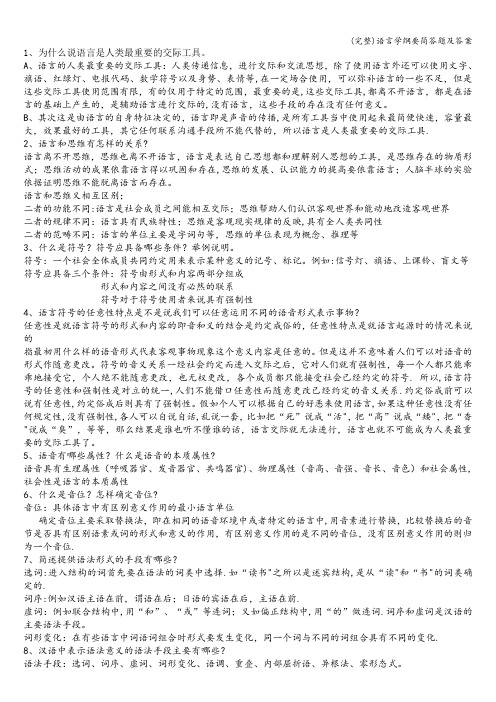
1、为什么说语言是人类最重要的交际工具。
A、语言的人类最重要的交际工具:人类传递信息,进行交际和交流思想,除了使用语言外还可以使用文字、旗语、红绿灯、电报代码、数学符号以及身势、表情等,在一定场合使用,可以弥补语言的一些不足,但是这些交际工具使用范围有限,有的仅用于特定的范围,最重要的是,这些交际工具,都离不开语言,都是在语言的基础上产生的,是辅助语言进行交际的,没有语言,这些手段的存在没有任何意义。
B、其次这是由语言的自身特征决定的,语言即是声音的传播,是所有工具当中使用起来最简便快速,容量最大,效果最好的工具,其它任何联系沟通手段所不能代替的,所以语言是人类最重要的交际工具.2、语言和思维有怎样的关系?语言离不开思维,思维也离不开语言,语言是表达自己思想都和理解别人思想的工具,是思维存在的物质形式;思维活动的成果依靠语言得以巩固和存在,思维的发展、认识能力的提高要依靠语言;人脑半球的实验依据证明思维不能脱离语言而存在。
语言和思维又相互区别;二者的功能不同:语言是社会成员之间能相互交际;思维帮助人们认识客观世界和能动地改造客观世界二者的规律不同:语言具有民族特性;思维是客观现实规律的反映,具有全人类共同性二者的范畴不同:语言的单位主要是字词句等,思维的单位表现为概念、推理等3、什么是符号?符号应具备哪些条件?举例说明。
符号:一个社会全体成员共同约定用来表示某种意义的记号、标记。
例如:信号灯、旗语、上课铃、盲文等符号应具备三个条件:符号由形式和内容两部分组成形式和内容之间没有必然的联系符号对于符号使用者来说具有强制性4、语言符号的任意性特点是不是说我们可以任意运用不同的语音形式表示事物?任意性是就语言符号的形式和内容的即音和义的结合是约定成俗的,任意性特点是就语言起源时的情况来说的指最初用什么样的语音形式代表客观事物现象这个意义内容是任意的。
但是这并不意味着人们可以对语音的形式作随意更改。
符号的音义关系一经社会约定而进入交际之后,它对人们就有强制性,每一个人都只能乖乖地接受它,个人绝不能随意更改,也无权更改,各个成员都只能接受社会已经约定的符号. 所以,语言符号的任意性和强制性是对立的统一,人们不能借口任意性而随意更改已经约定的音义关系.约定俗成前可以说有任意性,约定俗成后则具有了强制性。
语言学考试试题及答案
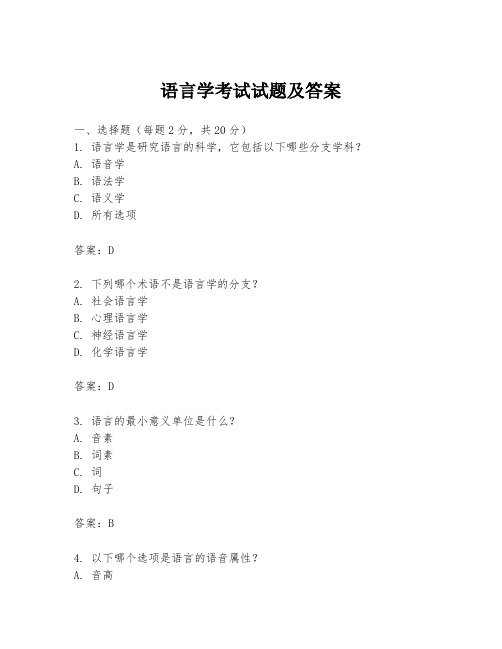
语言学考试试题及答案一、选择题(每题2分,共20分)1. 语言学是研究语言的科学,它包括以下哪些分支学科?A. 语音学B. 语法学C. 语义学D. 所有选项答案:D2. 下列哪个术语不是语言学的分支?A. 社会语言学B. 心理语言学C. 神经语言学D. 化学语言学答案:D3. 语言的最小意义单位是什么?A. 音素B. 词素C. 词D. 句子答案:B4. 以下哪个选项是语言的语音属性?A. 音高B. 音长C. 音色D. 所有选项答案:D5. 语言的语法规则可以是:A. 显性的B. 隐性的C. 两者都是D. 两者都不是答案:C6. 以下哪种语言现象不属于语言变异?A. 方言B. 社会方言C. 语言接触D. 语言消亡答案:D7. 语言的演变通常被认为是:A. 随机的B. 有目的的C. 无意识的D. 有意识的答案:C8. 语言接触可能导致:A. 语言融合B. 语言分离C. 语言借用D. 所有选项答案:D9. 语言的语用学研究的是:A. 语言的语境B. 语言的功能C. 语言的意义D. 所有选项答案:D10. 以下哪个术语不属于语义学研究的范围?A. 语义场B. 语义角色C. 语义关系D. 音位学答案:D二、填空题(每题2分,共20分)1. 语言的______属性包括音高、音长和音色。
答案:语音2. 语言的______属性包括语法、词汇和语义。
答案:结构3. 语言的______属性涉及语言的社会和文化方面。
答案:社会4. 语言学中的______理论认为语言是一系列规则的集合。
答案:形式主义5. 语言的______是语言学研究的基础单位。
答案:句子6. 语言的______是指语言在不同社会群体中的变体。
答案:变异7. 语言的______是指语言在不同地理区域的变体。
答案:方言8. 语言的______是指语言在不同时间的演变。
答案:历史9. 语言的______是指语言在不同语境中的使用。
答案:语用10. 语言的______是指语言的抽象意义。
语言学概论简答题

1、语言的作用是什么?请举例说明答:(1)语言是人类最重要的交际工具。
首先,语言是人类特有的交际工具,动物是没有语言的;其次,语言是适应人类需要而产生的,若人类不需要语言,就不会产生语言;再次,语言是信息载体,传递信息的代码;最后,交际职能是语言最基本的社会职能,其他功能只是它的派生物,它是社会成员相互联系的桥梁和纽带,是相互沟通和表达思想的工具。
(2)语言是人类的思维工具。
首先,思维离不开语言,语言是人类思维最有效的工具;其次,语言离不开思维,语言是思维的工具,在运用中才有意义,如果没有思维,就无所谓交际。
语言中词和句子的意义是思维赋予的。
语言与思维相互依存,各以对方的存在为前提;又相互适应,思维水平高,语言发展的水平就高。
2、语言实际上是一种特殊的社会现象,怎样理解这句话?答:社会现象是和人类共同体的一切活动有着密切联系的现象,语言就是社会现象。
语言不但是社会现象,而且是一种特殊的社会现象。
社会现象可分为经济基础和上层建筑两大类,经济基础就是人们在生产中形成的与一定的生产力发展水平相适应的生产关系的总和,上层建筑就是在经济基础上产生的并与之相适应的政治、法律、艺术、哲学、宗教等的总和。
语言作为社会现象的特殊性主要表现在,任何一种社会现象,要么属于经济基础,要么属于上层建筑,而语言既不属于经济基础,也不属于上层建筑,这两者的变化都不会从本质上影响语言。
很多社会现象都是具有阶级性的,比如属于上层建筑的法律、政治制度等,是为一定的统治阶级服务的,具有十分明显的阶级色彩,而语言则不属于那一个特定的阶级或阶层,而是属于社会全体成员。
所以语言是一种特殊的社会现象,作为交际工具,一视同仁地为社会全体成员服务。
因此,从本质上看,语言是人类共同的交际工具,不分阶级、阶层,一视同仁地为全社会的成员服务,没有阶级性,具有全民性特点。
语言社会性的具体表现:a、语言与社会相互依存1)语言依附社会:它随社会产生而产生;随社会发展而发展;随社会消亡而消亡。
语言学基础试题及答案

语言学基础试题及答案一、选择题(每题2分,共20分)1. 语言学是研究什么的科学?A. 语言的物理属性B. 语言的社会功能C. 语言的结构和功能D. 语言的历史发展答案:C2. 语音学研究的是语言的哪个方面?A. 语言的物理性质B. 语言的生理机制C. 语言的社会功能D. 语言的心理认知答案:A3. 下列哪项不是语言学的主要分支?A. 语音学B. 语法学C. 语用学D. 心理学答案:D4. 语言的最小意义单位是什么?A. 音素B. 词C. 语素D. 句子答案:C5. 语言中最小的可以独立运用的单位是什么?A. 音素B. 词C. 语素D. 句子答案:B6. 语言的交际功能不包括以下哪一项?A. 表达情感B. 传递信息C. 进行思考D. 艺术表现答案:C7. 语言的符号性质主要体现在哪个方面?A. 任意性B. 线性C. 离散性D. 系统性答案:A8. 语言的哪一项功能与语言的表达形式关系最为密切?A. 认知功能B. 社会功能C. 表达功能D. 工具功能答案:C9. 语言的哪一项功能与语言的交际目的关系最为密切?A. 认知功能B. 社会功能C. 表达功能D. 工具功能答案:B10. 语言的哪一项功能与语言的内在结构关系最为密切?A. 认知功能B. 社会功能C. 表达功能D. 工具功能答案:A二、填空题(每题2分,共20分)1. 语言学研究语言的________和________。
答案:结构、功能2. 语音学是研究语言的________和________的学科。
答案:物理性质、生理机制3. 语言学的主要分支包括语音学、语法学、语用学和________。
答案:语义学4. 音素是语言中最小的________单位。
答案:区别性5. 语素是语言中最小的________单位。
答案:意义6. 语言的交际功能包括表达情感、传递信息、________和艺术表现。
答案:进行思考7. 语言的符号性质主要体现在其________上。
语言学全部习题

语言学全部习题1. 简答题(每题10分,共30分)1) 什么是语言学?语言学是研究语言的科学,包括语音学、词法学、句法学、语义学、语用学等不同的分支。
它关注语言的结构、用法、演变以及和思维、社会和文化之间的关系。
2) 语言的基本要素包括哪些?语言的基本要素包括语音、词汇、句法、语义和语用。
语音研究发音和音系,词汇研究词的形态和词义,句法研究语言的句子结构,语义研究词和句的含义,语用研究语言的使用和交际。
3) 语音学和音系学有何区别?语音学研究语言中的语音现象,包括语音的产生、传播和感知等方面。
音系学研究语言中的音素系统,即语言中所有可能出现的音位和它们的组合规则。
2. 选择题(每题10分,共40分)1) 下列哪个不属于语言的基本要素?A. 语音B. 词汇C. 句法D. 语文答案:D2) 以下哪个学科不是语言学的分支?A. 语音学B. 语用学C. 数学D. 词法学答案:C3) 语音学主要研究哪方面的内容?A. 词义B. 词形C. 词语的使用D. 语音的产生和感知答案:D4) 以下哪个不是语言学的研究对象?A. 词汇表B. 句子结构C. 语言和思维的关系D. 社会语言规范答案:A3. 简答题(每题10分,共30分)1) 什么是语言的演变?语言的演变是指语言在使用过程中,由于多种因素的影响,其语音、词汇、句法等方面发生变化和发展。
语言的演变是一个长期的、渐进的过程,涉及到语言交流者的语言习惯、语音产生的方式、语法规则的改变等方面的变化。
2) 语言和思维之间有何关系?语言和思维之间有密切的关系。
一方面,语言是人类思维的表达工具,通过语言的运用,人们能够将思维中的概念、情感和意图等传递给他人。
另一方面,语言也影响思维的方式和内容。
语言结构和词汇的差异会影响人们的思维方式,不同语言对概念的划分和认知方式可能会有所不同。
3) 什么是语言交际?语言交际指的是人们通过语言进行沟通和交流的过程。
语言交际包括语言的使用、理解和解释,以及交流中的非语言行为和语境等因素。
语言学入门考试题及答案

语言学入门考试题及答案一、选择题(每题2分,共20分)1. 语言学的主要研究对象是什么?A. 语言B. 文学C. 历史D. 数学答案:A2. 以下哪个选项不属于语言学的分支?A. 语音学B. 语法学C. 心理学D. 语义学答案:C3. 语言学研究的是哪类现象?A. 物理现象B. 自然现象C. 社会现象D. 文化现象答案:C4. 语言的最小意义单位是什么?A. 音素B. 词C. 句子D. 语篇答案:A5. 以下哪个术语不属于语言变异?A. 方言B. 社会方言C. 语言接触D. 语言死亡答案:D6. 语言的哪一层级负责表达意义?A. 语音层B. 语法层C. 语义层D. 语用层答案:C7. 以下哪个选项是语言的交际功能?A. 表达情感B. 描述事物C. 命令他人D. 所有选项答案:D8. 以下哪个选项是语言的内部结构?A. 音位B. 词汇C. 语音D. 语法答案:D9. 以下哪个选项是语言的外部功能?A. 信息传递B. 情感表达C. 命令控制D. 所有选项答案:D10. 语言的哪一层级负责表达关系?A. 语音层B. 语法层C. 语义层D. 语用层答案:B二、填空题(每题2分,共20分)1. 语言学研究的最小意义单位是________。
答案:音素2. 语言学研究的最小语音单位是________。
答案:音位3. 语言学研究的最小语法单位是________。
答案:词4. 语言学研究的最小语义单位是________。
答案:词义5. 语言学研究的最小语用单位是________。
答案:句子6. 语言学研究的最小社会单位是________。
答案:方言7. 语言学研究的最小文化单位是________。
答案:语言8. 语言学研究的最小交际单位是________。
答案:话语9. 语言学研究的最小心理单位是________。
答案:概念10. 语言学研究的最小认知单位是________。
答案:思维三、简答题(每题10分,共30分)1. 简述语言学的主要研究内容。
语言学概论 简答题

语言学概论1. 为什么语言和种族没有必然联系?语言能力和生理因素、心理因素有关,但语言不是一种生理现象,也不是一种心理现象,不是遗传的,而是一种社会现象。
语言完全是在一种语言环境中后天获得的,所以语言和种族没有必然联系。
2. 简答语言符号的特点。
(1)符号和语言,“能指”和“所指”。
能指是能够指称某种意义的成分,所指是给符号所指的意义内容创制了一个专门术语。
(2)语言符号的“任意性”。
符号的物质实体和表示的意义之间没有必然的理据关系,语言符号的物质实体和表示的意义之间也没有必然的理据关系,完全是任意的,约定俗成的。
(3)语言符号的强制性和可变性。
在同一社会、同一时代,对使用同一种语言的每一个社会成员来说是强制性的,而语言又是发展变化着的。
(4)语言符号的离散特性和线性特性。
话只能一个字一个字,一句话一句话地说,因此语言符号是离散的,而且在时间这根轴上是成线性排列的。
3. 组合关系和聚合关系的关系。
组合关系体现在一个语言单位和前一个语言单位或后一个语言单位,或和前后两个语言单位之间的关系,是横向关系。
聚合关系是在组合的某一个位置上能够相互替换,有共同的特点,故能聚合归类。
组合是横向的结构关系,聚合是归类规则,有了组合、聚合关系,便展现出了整个语言平面,聚合关系是组合关系中体现出来的,或者说是从组合关系中分析出来的,而组合关系又表现为聚合类的线性序列。
所以组合关系和聚合关系是有机地统一,不可分割。
4. 解释“符号”。
符号指根据社会的约定俗成使用某种特定的物质实体来表示某种特定的意义而形成的实体和意义的结合体。
5. 解释“语言”。
语言是言语活动中同一社会群体共同掌握的,有规律可循而又成系统的那一部分,语言是均质的,是言语活动中的社会部分。
语言作为一种社会现象具有鲜明的地区性、民族性和历史性。
6. 口语和书面语的关系。
语言的客观存在形式首先是口语,第二种客观存在形式,是书面语。
书面语是在口语的基础上产生的,口语是第一性的,书面语是第二性的。
6语言学概论.简答题复习题库

简答题:语言的本质部分1.“狼孩子”的故事说明了什么?2.与语言相对,言语具有什么特点?3.为什么人类语言具有灵巧的构造?参考答案:o 1.“狼孩子”的故事说明了什么?【参考答案】A.语言是人类社会特有的现象。
(2分)B.离开人类社会就没有语言。
(2分)C.孩提时期是学会语言.掌握语言的一个重要的阶段。
(2分)D.如果错过了这个最好的时机,•就很难学会一种语言。
(1分)2.与语言相对,言语具有什么特点?【参考答案】言语的具体性、个人性、临时性、无限性、多变性、物质性等特点。
(每小点1分,表述1分)3.为什么人类语言具有灵巧的构造?【参考答案】A.任意性;B.离散性;C. 层级性。
(每一小点2分,表述1分)简答题:语音学部分1.指出汉语普通话/a/音位的几个条件变体,描述其发音特点和出现条件。
2.指出汉语普通话/e音位的几个条件变体,描述其发音特点和出现条件。
3.语音的四要素是什么?在语言中各有什么作用?4.音质的不同取决于哪些条件?举例说明。
5.什么是音位的区别特征?普通话音位/p/的区别特征主要有哪些?6.什么是音位?划分音位的主要原则是什么?举例说明。
7.举例说明音位的条件变体和自由变体有什么不同?在普通话中[p]和[b]是不是音位变体?是什么变体?8.举例说明舌面元音的三维特点。
参考答案:1. 指出汉语普通话 a 音位的几个条件变体,描述其发音特点和出现条件。
【参考答案】A./a/ 音位的条件变体有四个:[a]、[¢]、[ɑ]、[E](1分)B. 发音特点(3分)••••••• [a] 前、低、不圆唇舌面元音••••••• [ ] 央、低、不圆唇舌面元音••••••• [ɑ] 后、低、不圆唇舌面元音••••••• [E] 前、半低、不圆唇舌面元音C. 出现条件(3分)••••••• [a] 在韵尾[i]、[n]之前••••••• [¢] 无韵尾••••••• [ɑ] 在韵尾[u]、[ ]之前••••••• [E ] 在韵头[i]或[y]同韵尾[n]之间2.指出汉语普通话 e 音位的几个条件变体,描述其发音特点和出现条件。
语言学纲要考试题及答案
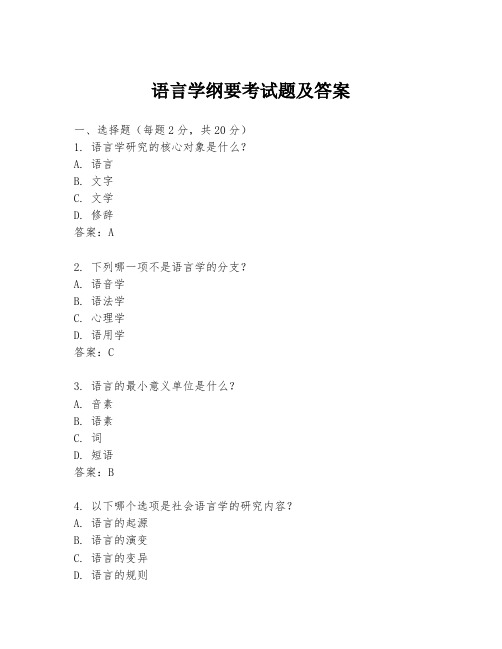
语言学纲要考试题及答案一、选择题(每题2分,共20分)1. 语言学研究的核心对象是什么?A. 语言B. 文字C. 文学D. 修辞答案:A2. 下列哪一项不是语言学的分支?A. 语音学B. 语法学C. 心理学D. 语用学答案:C3. 语言的最小意义单位是什么?A. 音素B. 语素C. 词D. 短语答案:B4. 以下哪个选项是社会语言学的研究内容?A. 语言的起源B. 语言的演变C. 语言的变异D. 语言的规则答案:C5. 语言学中,对语言的静态研究指的是什么?A. 历史语言学B. 比较语言学C. 结构语言学D. 应用语言学答案:C6. 语言的音位系统是由什么决定的?A. 社会B. 个人C. 语言本身D. 环境答案:C7. 在语言学中,语言的功能不包括以下哪一项?A. 表达功能B. 交际功能C. 娱乐功能D. 认知功能答案:C8. 下列哪一项是语言的内在属性?A. 语法性B. 社会性C. 工具性D. 规范性答案:A9. 语言的演变主要受哪些因素的影响?A. 社会变迁B. 经济发展C. 政治变动D. 所有以上答案:D10. 语言的交际功能主要体现在哪些方面?A. 信息传递B. 情感表达C. 社会互动D. 所有以上答案:D二、填空题(每空1分,共20分)1. 语言学的三大基本分支是______、______和______。
答案:语音学、语法学、语义学2. 语言的______性是语言学研究的重要内容之一。
答案:社会3. 语言的______是语言学研究的基础。
答案:结构4. 语言的______是语言研究的核心问题。
答案:意义5. 语言的______是语言学研究的重要方面。
答案:变化6. 语言学研究的目的是______、______和______语言。
答案:描述、解释、预测7. 语言的______是语言研究的重要内容。
答案:变异8. 语言的______是语言研究的重要方面。
答案:起源9. 语言的______是语言研究的重要内容。
语言学试题及答案

语言学试题及答案一、选择题1. 语言学是一门研究语言的科学,它主要关注语言的哪些方面?A. 语音和语法B. 词汇和语义C. 语音、语法、词汇和语义D. 语法和语用答案:C2. 下列哪个选项不属于语言学的分支学科?A. 语音学B. 语法学C. 心理学D. 语用学答案:C3. 语言的最小意义单位是什么?A. 音素B. 词C. 语素D. 句子答案:C二、填空题4. 语言学中的“_______”是指语言的物理表现形式。
答案:语音5. 语言学中的“_______”是指语言的抽象系统,包括语法规则和词汇。
答案:语法6. 语言学中的“_______”是指语言的最小意义单位。
答案:语素三、简答题7. 简述语言学的主要研究方法。
答案:语言学的主要研究方法包括观察法、实验法、调查法、统计法等。
观察法是通过观察语言现象来收集数据;实验法是在控制条件下进行语言实验以验证假设;调查法是通过问卷、访谈等方式收集语言使用情况;统计法是利用统计学原理分析语言数据。
8. 描述语言学和历史语言学的区别。
答案:描述语言学关注的是特定语言在某一特定时间点的状态,它试图描述和解释语言的结构和功能;而历史语言学关注的是语言随时间的变化和发展,研究语言的起源、演变以及不同语言之间的亲缘关系。
四、论述题9. 论述语言与文化之间的关系。
答案:语言与文化之间存在着密切的关系。
首先,语言是文化的载体,通过语言可以传递和保存文化信息。
其次,语言反映了文化的特点,不同文化背景下的语言会有不同的表达方式和词汇。
此外,语言的使用也受到文化规范和价值观的影响,例如礼貌用语、禁忌语等。
最后,语言的发展和变化也受到文化因素的影响,文化变迁往往伴随着语言的演变。
10. 分析语言的多样性对全球化的影响。
答案:语言的多样性对全球化有着复杂的影响。
一方面,语言多样性丰富了人类的文化生活,促进了不同文化之间的交流与理解。
另一方面,语言多样性也带来了沟通上的障碍,全球化进程中需要跨越语言障碍以实现信息的自由流通。
- 1、下载文档前请自行甄别文档内容的完整性,平台不提供额外的编辑、内容补充、找答案等附加服务。
- 2、"仅部分预览"的文档,不可在线预览部分如存在完整性等问题,可反馈申请退款(可完整预览的文档不适用该条件!)。
- 3、如文档侵犯您的权益,请联系客服反馈,我们会尽快为您处理(人工客服工作时间:9:00-18:30)。
●Why is productivity unique to language?The productivity of language is the property which enables its users to construct and understand an indefinitely large number of utterances, including the novel utterances that they have never said nor heard before. This feature is unique to human language because most animal communication systems appear to be highly restricted with respect to the number of different signals that their users can send and receive. For example, a gibbon call system lacks productivity, for gibbons draw all their calls from a limited repertoire, which is rapidly exhausted, making any novelty impossible; and bee dancing is used only to indicate nectar sources, which is the only kind of message that can be sent through the dancing.●How is Saussure's distinction between langue and parole similar to Chomsky's distinstion between competenceand performance?According to F·de Saussure, langue refers to the abstract linguistic system shared by all the members of a speech community and parole refers to the realization of langue in actual use. Chomsky defines competence as the ideal user's knowledge of the rules of his language, and performance the actual realization of this knowledge in linguistic communication. From these definitions we find that both Saussure and Chomsky make the distinction between the abstract language system and the actual use of language. Their purpose is to single out the language system for serious study.●What are the major branches of linguistics? What does each of them study?The major branches of linguistics include phonetics, phonology, morphology, syntax, semantics, pragmatics, sociolinguistics, psycholinguistics and applied linguistics.Phonetics studies how speech sounds are produced and classified. Phonology studies how sounds form systems and function to convey meaning. Morphology studies how morphemes are combined to form words. Syntax studies how morphemes and words are combined to form sentences. Semantics studies meaning (in abstraction). Pragmatics studies meaning in context of use. Sociolinguistics studies language with reference to society. Psycholinguistics studies language with reference to the workings of the mind. Applied linguistics studies the application of linguistic principles and theories to language teaching and learning.●Why is syntax regarded as a system of rules?As a major component of grammar, syntax consists of a set of abstract rules that allow words to be combined with other words to form grammatical sentences. A sentence is considered grammatical when it conforms to the grammatical knowledge in the mind of native speakers. If, on the other hand, a sentence violates a rule according to which words are organized, then native speakers will judge it to be an impossible sentence of that language. Universally found in the grammars of all human languages, syntactic rules comprise the system of internalized linguistic knowledge of a language speaker. For any natural language, it is the set of rules that makes it possible for the speakers to produce, comprehend and memorize the vast number of sentences of their native language.●What makes modern linguistics different from traditional grammer?Traditional grammar is based on “high”(religious, literary) written language. It is prescriptive. It sets models for language users to follow. It tells the learner what he should say, or what is supposed to be correct usage. On the other hand, modern linguistics is mostly descriptive. Modern linguistics is supposed to be scientific and objective and the task of linguists is supposed to describe the language people actually use, be it "correct" or not. Its investigations and analysis are based on authentic, and mainly spoken language data.●What is a free morpheme? What is a bound morpheme? And how are they different from each other?Free morphemes are morphemes which are independent units of meaning and can be used freely all by themselves, such as help, table, able, etc. Bound morphemes are morphemes that cannot be used by themselves, but must be combined with other morphemes, either free or bound, to form a word, such as “-en”in “enlarge”, “dis-”in “disable”, “im-”in “impossible”.●What do langue and parole mean respectively?According to F·de Saussure, langue refers to the abstract linguistic system shared by all the members of a speech community, and parole refers to the realization of langue in actual use. Langue is the set of conventions and rules which language users all have to abide by; it is abstract. Parole is the concrete use of the conventions and the application of the rules; it is concrete.●Why is the word order in Modern English more rigid than that in Old English?The word order in Modern English is more rigid than that in Old English. This is because in Modern English there are no longer the elaborate morphological system used in Old English, such as the case marking system, to help to indicate grammatical relations. Therefore, it is no longer possible to identify the functional roles of nouns by their inflectional endings. The functional notions of subject and object have to be indicated largely by the syntactic position of nouns in a linear order, resulting in a system with stricter constraints on word order.●What characteristics of language do you think should be included in a good, comprehensive definition oflanguage?a. Language is a rule-governed system.b. Language is basically vocal.c. Language is arbitrary.d. Language is used for human communication.●What are suprasegmental features? How do the major suprasegmental features of English function in conveyingmeaning?The phonological features that occur above the sound segmental level are called suprasegmental features. The major suprasegmental features of English include word stress, sentence stress and intonation. The suprasegmental features distinguish meaning.●What is Broca's area and what would happen if any damage were inflicted upon it?In 1861, a French surgeon and anatomist Paul Broca discovered that somewhere in the frontal lobe in the left cerebral hemisphere had something to do with speech difficulty. This place is now known as Broca's area. According to his claim in 1865, any damage to sites in the left cerebral hemisphere will result in a patient's language disorder, whereas destruction of corresponding sites in the right hemisphere leave linguistic capacities intact. Therefore if any damage is inflicted upon this area, it will result in word finding difficulties and problems with syntax.●State briefly your understanding of the differences between the term acquisition and the term learning inlanguage acquisition study?The distinction between acquisition and learning was proposed by the American SLA scholar Stephen Krashen on the assumption that they are different processes. Acquisition refers to the gradual and subconscious development of ability in the first language by using it naturally in daily communicative situations. Learning, however, is defined as a conscious process of accumulating knowledge of a second language usually obtained in school settings. It is recognized that children acquire their native language without explicit learning, while a second language is more commonly learned but to some degree may also be acquired, depending on the environmental setting and the input received by the L2 learner. A rule can be learned before it is internalized(i.e. acquired), but having learned a rule does not necessarily preclude having to acquire it later.●Why is language defined as a system of arbitrary vocal symbols used for human communication?Short as it is, this definition has captured the main features of language. First of all, language is a system, i.e., elements oflanguage are combined according to rules. If language were not constructed according to certain rules, it could not be learned or used consistently. Second, language is arbitrary in the sense that there is no intrinsic connection between a word and the thing we use to write with. The fact that different languages have different words for the same object is a good illustration of the arbitrary nature of language. Third, language is vocal because the primary medium is sound for all languages, no matter how well developed their writing systems are. All evidence points to the fact that writing systems came into being much later than the spoken forms and that they are only attempts to capture sounds and meaning on paper. Finally, the term "human" in the definition is meant to specify that language is human specific, i.e. it is very different from the communication systems other forms of life possess, such as bird songs and bee dances.●What is universal grammar?Universal grammar, also known as the principles-and-parameters theory, is a system of linguistic knowledge and a human species-specific gift which exists in the mind or brain of a normal human being. Its general principles include case condition and adjacency condition, the former requires that a noun phrase must have case and case is assigned by verb or preposition to the object position, or by auxiliary to the subject position; the latter states that a case assignor and a case recipient should stay adjacent to each other, which explains why no other phrasal category can intervene between a verb and its direct object. The parameters on the other hand includes adjacency parameter and directionality parameter. The former accounts for the specific word order patterns of a certain language, the latter concerns the directionality of case assignment.●What is the nature of language change in historical linguistics?On the one hand, language change is inevitable. As a general rule, language change is universal, continuous and, to a considerable degree, regular and systematic. Language change is extensive, taking place in virtually all aspects of the grammar —in phonology, morphology, syntax, lexicon and semantics. When language change is in progress, phonemes, morphemes, words, and grammatical rules may be borrowed, added, lost, or altered, and meanwhile, the meaning of individual lexical items or strings of words may expand, narrow, or shift.On the other hand, though language change is universal and even vigorous in some cases, the truth of the matter is that it is never an overnight occurrence. The historical development of a language is hardly a sudden transformation of one language into another language, but a gradual and constant process, often indiscernible to speakers of the same generation.●What's the difference between the instrumental motivation and the integrative motivation of the learner's? Usually, adults are motivated to learn a second language because of a communicative need. They may learn a second language in order to use it functionally when they intend to use it as an instrument for the purpose of, for instance, securing a desirable job or passing an important examination, or socially when they intend to use it as a means to integrate themselves with the second language community. In certain situations an integrative motivation may be more powerful in facilitating successful second language learning, but in other situations instrumental motivations may count for more. Where the target language functions as a foreign language (used in a limited environment such as in school), the learner is likely to benefit from an integrative motivation; but where the target language functions as a second language (used as a primary means of communication in the community of the learner), an instrumental motivation is more effective.●What are the main design features of human language?here are many defining properties of human language that distinguish it from any animal system of communication, here only a few to mention: Arbitrariness means that there is no logical connection between meanings and sounds, this nature enables language to have an unlimited source of expressions; Productivity makes its users possible to construct and interpret any new signals, by means of which they can produce and understand an infinitely large number of sentences, including sentences they have never heard before; Duality means language consists of two sets of structures, or two levels; at the lower or the basic level there is a structure of sounds, which are meaningless, but they can be grouped and regrouped into a large number of units of meaning such as morphemes and words, which are found at the higher level of the system; Displacement designates that language users may refer to things which are present or not present, real or imagined matters in the past, present, or future, or in far away places; At last, cultural transmission implies that language is culturally transmitted.●How many morphemes are there in the English language? State what they are and illustrate how they work. There are two types of morphemes in the English language: free morphemes are independent units of meaning and can be used freely all by themselves such as help, table, room, etc.; bound morphemes are those that cannot be used independently but have to be combined with other morphemes, either free or bound, to form a word, it includes two types: a root is often seen as part of a word; it can never stand by itself although it bears clear, definite meaning, it must be combined with another root or an affix to form a word. For example, the root “geo”bears the meaning of “the earth”, when it combines with another root “-ology”, meaning “a branch of learning”; affixes are morphemes that are added to an already existing morpheme to form a new word while changing its meaning and grammatical relations. It consists of both inflectional affixes and derivational affixes.●What is the difference between a pidgin and creole?A pidgin is a variety of language that is generally used by native speakers of other languages as a medium of communication used for some practical purposes. It is a simplified language with reduced vocabularies, originating most often from the higher dominant language and an absence of grammatical features such as case, tense, mood and voice, etc. On the other hand, a creole language is originally a pidgin that has become established as a native language in some speech community. That is, when a pidgin comes to be adopted by a population as its primary language, and children learn it as their first language, then the pidgin language is called a creole. In contrast with a pidgin, creoles are fully developed languages as complete in every way as other languages. When a pidgin begins to play the role of a trade language, it undergoes considerable expansion of its vocabulary and grammar and begins to acquire rules comparable in nature and complexity with the rules of any other human natural language, then it becomes a creole.●What are the two major functions of language?Language can serve two major functions, namely, interpersonal communication and interpersonal communication. First, language functions as a means of interpersonal communication when language users use it to convey information, thoughts and feelings from one person to another or to control each other's behavior. Secondly, it functions as a means of intrapersonal communication when it is used as a means to facilitate thinking, speech behavior and action for the individual.。
